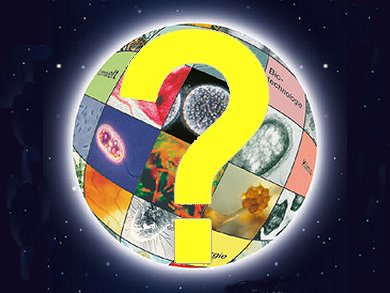Microbes, the most fascinating and underrated organisms on the planet, were the subject of the quiz Microbial World. Did you get the answers right? Find out below.
1. What are the three branches of cellular life?
Bacteria, Archaea, and Eukarya are the three branches of cellular life.
For more information see: Chapter 3 of Discover the World of Microbes: Bacteria, Archaea, and Viruses.
2. How many more microbes does an average human have compared to own body cells?
The number of bacteria living within the body of the average healthy adult human are estimated to outnumber human cells 10 to 1.
For more information see: Chapter 10 of Discover the World of Microbes: Bacteria, Archaea, and Viruses.
3. Which enzyme catalyzes the equivalent of the Haber-Bosch reaction and in what classes of organisms do you find this enzyme?
The nitrogenase enzyme catalyzes the equivalent of the Haber-Bosch reaction and is found in diazotrophic bacteria and archaea.
For more information see: Chapter 11 of Discover the World of Microbes: Bacteria, Archaea, and Viruses.
4. Which eukaryotic organelles are derived from bacteria?
Mitochondria and plastids.
For more information see: Chapter 27 of Discover the World of Microbes: Bacteria, Archaea, and Viruses.
5. Everyone knows that yeast and grape juice make wine; how is vinegar traditionally produced?
Fermentation of ethanol by acetic acid bacteria.
For more information see: Chapter 18 of Discover the World of Microbes: Bacteria, Archaea, and Viruses.
6. Where in nature do you find plasmids and what is the advantage of having one?
Plasmids are found as small circular, double-stranded DNA molecules in bacteria, and sometimes in archaea and eukaryotic organisms. In nature, plasmids carry genes that may benefit survival of the organism (e.g., antibiotic resistance), and can frequently be transmitted from one bacterium to another. Artificial plasmids are widely used as vectors in molecular cloning, serving to drive the replication of recombinant DNA sequences within host organisms.
For more information see: Chapter 23 of Discover the World of Microbes: Bacteria, Archaea, and Viruses.
7. Which gas is in the Emmentaler cheese holes and how is it produced?
Carbon dioxide gas is produced in Emmentaler cheese holes. Three types of bacteria are used in the production of Emmentaler: Streptococcus thermophilus, Lactobacillus, and Propionibacterium freudenreichii. In the late stage of cheese production, P. freudenreichii consumes the lactic acid excreted by the other bacteria, and releases carbon dioxide gas, which slowly forms the bubbles that make holes.
For more information see: Chapter 18 of Discover the World of Microbes: Bacteria, Archaea, and Viruses.
8. Does photosynthesis always produce oxygen? If not, what else is produced?
No, there is anoxygenic photosynthesis where the end product can be elemental sulphur which is further oxidised to sulphuric acid.
For more information see: Chapter 9 of Discover the World of Microbes: Bacteria, Archaea, and Viruses.
9. What is biogas and which organisms produce it?
Biogas refers to a gas produced by breakdown of organic matter in the absence of oxygen. It is carried out by anaerobic bacteria. The digestion process begins with bacterial hydrolysis of the input materials to break down insoluble organic polymers, such as carbohydrates, and make them available for other bacteria. Acidogenic bacteria then convert the sugars and amino acids into carbon dioxide, hydrogen, ammonia, and organic acids. Acetogenic bacteria then convert these resulting organic acids into acetic acid, along with additional ammonia, hydrogen, and carbon dioxide. Finally, methanogens convert these products to methane and carbon dioxide.
For more information see: Chapter 17 of Discover the World of Microbes: Bacteria, Archaea, and Viruses.
10. Which organisms grow in boiling water?
Hyperthermophiles grow in boiling water. E.g., Thermococcus kodakarensis, Thermus aquaticus.
For more information see: Chapter 6 of Discover the World of Microbes: Bacteria, Archaea, and Viruses.
11. What is EHEC standing for?
Entero haemorrhagic Escherichia coli.
For more information see: Chapter 29 of Discover the World of Microbes: Bacteria, Archaea, and Viruses
The winner of the book “Discover the World of Microbes” are: S. Ramachandran, India, S. N. Zagrebelny, Russia, and Z. Guanghong, China.
- Discover the World of Microbes: Bacteria, Archaea, and Viruses,
Gerhard Gottschalk,
Wiley-VCH, Weinheim, Germany, 2011.
ISBN: 978-3-527-32845-1 - Quiz: Microbial World,
Gregor Cicchetti and Vera Köster,
ChemViews Magazine, 2012, December.
DOI: 10.1002/chemv.201200151
Test your knowledge of microbes, the most fascinating and underrated organisms on the planet
Also of interest:
- Are Microbes the Future of Bioenergy? – Interview with Gerhard Gottschalk,
Gregor Cicchetti and Vera Köster,
ChemViews Magazine, 2012, September.
DOI: 10.1002/chemv.201200098
Professor Gerhard Gottschalk, Germany, discusses his views on bacteria’s role in the future of bioenergy




